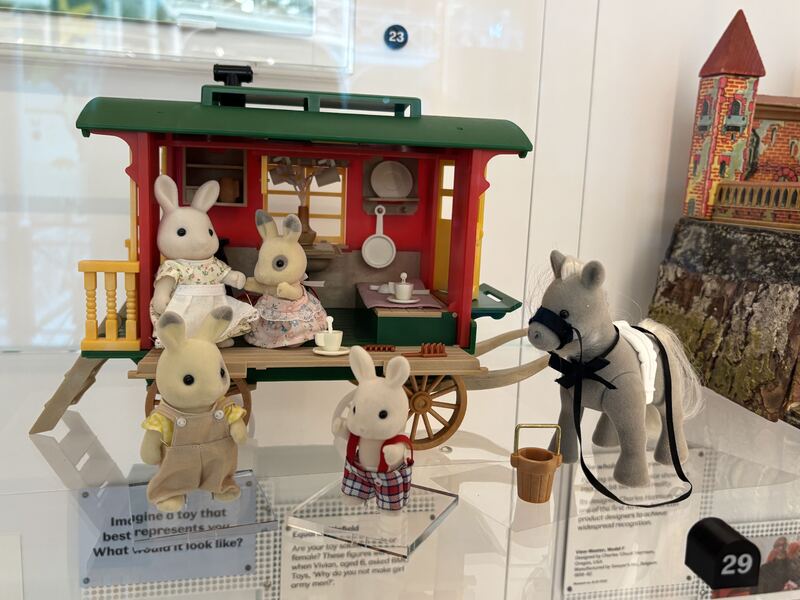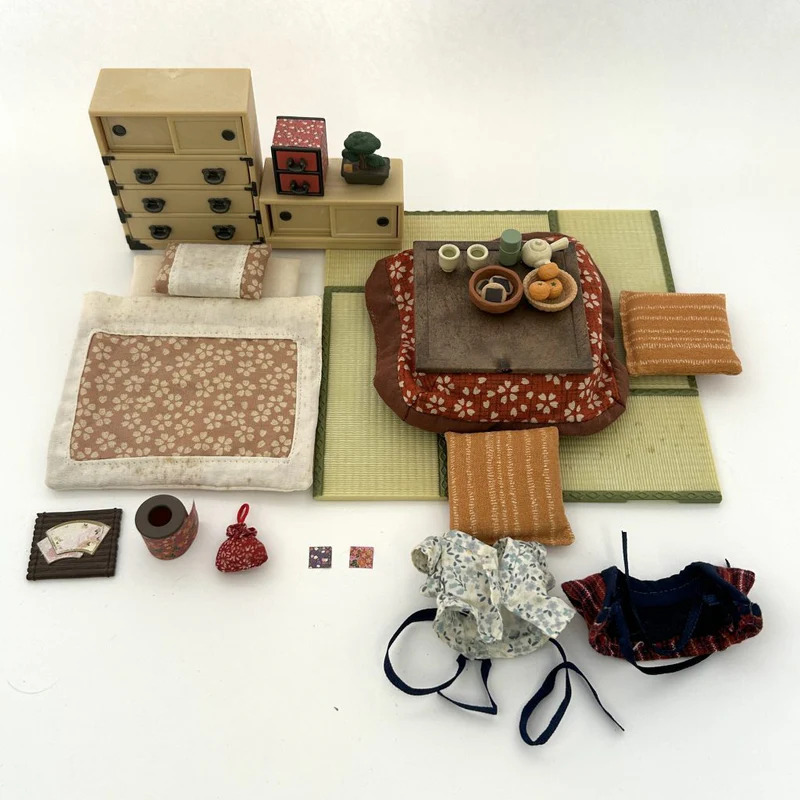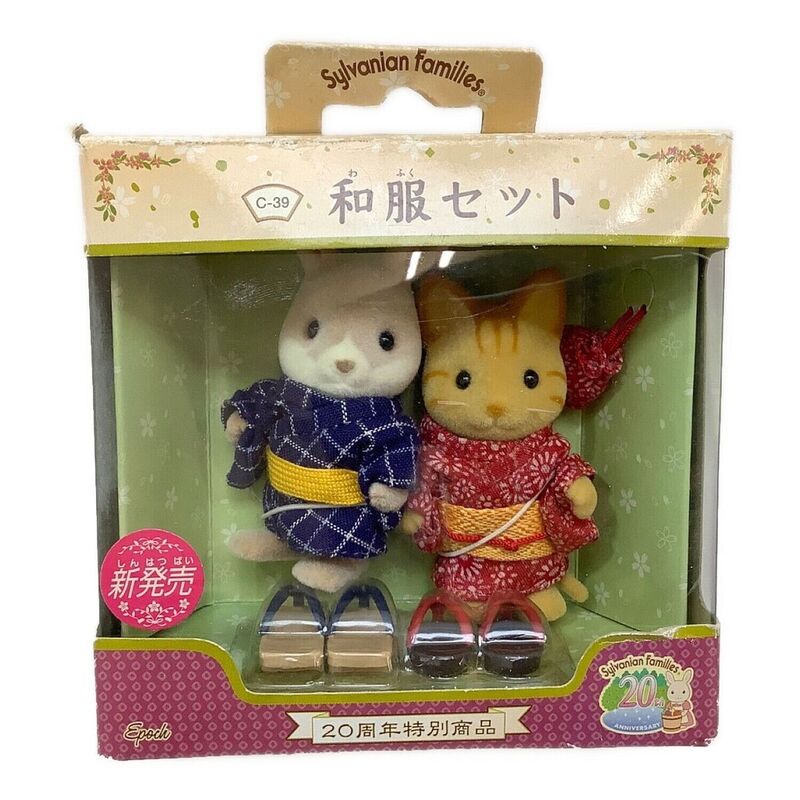
Sylvanian Families and Cultural Storytelling: A Cross-Cultural Analysis of Toys as Educators
Karlie Sikorski, Spring 2025
In a cozy London flat, a young girl carefully arranges a family of fuzzy animal figurines into a miniature red post office. She hums as she pretends one rabbit mails a letter while another waits patiently by a red telephone box. Half a world away in a quiet Kyoto home, another child adjusts the tiny bonsai tree on her Sylvanian tea room set. Dressed in a miniature kimono, her cat figure bows politely before serving tea. Though thousands of miles apart and raised in different cultural contexts, both children are playing with Sylvanian Families, the stories they tell and the worlds they build are shaped by the traditions and values embedded in their toys.
Toys have long served as more than mere playthings; they are instrumental in transmitting cultural values, norms, and societal expectations to children. From the ornate dollhouses of Victorian England to the globally cherished Sylvanian Families, toys encapsulate the ethos of their originating cultures. Sylvanian Families, with their anthropomorphic animal characters and detailed playsets, offer a unique lens through which to examine how toys function as cultural educators. This essay explores how Sylvanian Families, through their region-specific adaptations in the United Kingdom and Japan, reflect and impart cultural narratives, thereby influencing children's perceptions of society.
Historically, toys have been pivotal in socializing children into their expected societal roles. Dollhouses, for instance, originated in Europe as tools to teach young girls domestic management skills, mirroring the societal emphasis on women's roles within the household. Antonia Fraser, in her seminal work A History of Toys, elucidates how such toys were not merely for amusement but were imbued with lessons on domesticity, gender roles, and social conduct. These early toys laid the groundwork for understanding how playthings can serve as conduits for cultural transmission.
Introduced in 1985 by the Japanese toy company Epoch Co., Sylvanian Families quickly gained international acclaim for their charming animal figures and intricately designed playsets. Originally launched in Japan, the line was designed to reflect an idyllic countryside lifestyle, blending elements of nature, family, and community. Its success soon spread to international markets, particularly the United Kingdom, where it became a cultural staple. Beyond their aesthetic appeal, these toys are meticulously crafted to resonate with specific cultural contexts, thereby serving as tools for cultural education. The brand's adaptability to various cultural milieus underscores its role in reflecting and reinforcing regional values and traditions.
In the UK, Sylvanian Families playsets incorporate iconic elements of British culture, subtly educating children about their national heritage. One example is the horse-drawn caravan, which reflects the UK's rich history of Romani culture and countryside caravanning; this playset, featured at the Young V&A Museum, introduces children to traditional modes of travel and the nomadic lifestyle. Another is the river canal boat set, inspired by the UK’s extensive canal systems and the communities that inhabit them, familiarizing children with alternative living arrangements and the historical significance of waterways. The inclusion of red telephone boxes and police boxes, emblematic of British public services, reinforces the importance of community infrastructure and civic responsibility. Similarly, the post office set, featuring the iconic red post boxes seen throughout London, emphasizes the role of communication and the postal system in daily British life. Through these culturally specific playsets, children engage with representations of British life, fostering a sense of national identity and cultural familiarity.
In Japan, Sylvanian Families playsets are designed to reflect traditional customs and aesthetics, providing children with hands-on exposure to elements of their cultural heritage. The 20th Anniversary Kimono Set, which features a rabbit and a cat dressed in formal male kimonos, introduces children to traditional Japanese attire and the ceremonial significance of such garments. This playset subtly reinforces cultural dress codes and fosters an appreciation for historical fashion and its role in social rituals. The Japanese Room Set offers a detailed miniature of a classic tatami-style living space, complete with floor mats, a low tea table, a bonsai tree, and a kimono-clad rabbit. It introduces children to the spatial and aesthetic principles of Japanese interior design, as well as the cultural importance of shared tea rituals. Together, these sets serve as interactive tools through which children can explore and internalize aspects of Japanese culture, traditions, and values through imaginative play.
The UK and Japanese adaptations of Sylvanian Families highlight distinct approaches to cultural education through toys. While UK playsets emphasize public services and communal living—reflecting a society that values tradition and civic engagement—Japanese playsets focus on historical customs and aesthetic principles, underscoring the importance of heritage and ritual. These differences in toy design mirror the distinct child-rearing practices and societal values of each culture. Research indicates that children's play behaviors are influenced by cultural contexts, with toys serving as mediums for cultural transmission. For instance, a study analyzing children's interactions with culturally diverse toys found that play is shaped by the child’s cultural background, thereby reinforcing norms and expectations embedded in their society (Ezmeci et al.).
Psychological and anthropological research underscores the role of toys in shaping cultural learning, with studies revealing how children interact with objects to internalize societal norms. In a cross-cultural analysis, Riede et al. (2022) argue that toys serve as tools for "enskillment," a process through which children acquire cultural knowledge and social skills. They examine how different societies use objects in play to transmit specific skills and values, such as communal cooperation in hunter-gatherer societies. This concept can be applied to Sylvanian Families, where each culturally tailored playset serves as a means for children to engage with and internalize distinct societal values and practices. For instance, the traditional British countryside lifestyle represented by the horse-drawn caravan or the canal boat set aligns with societal values around community and public services, reflecting a particular worldview that children can engage with through play.
Furthermore, psychological theories, such as Lev Vygotsky’s cultural-historical psychology, suggest that play is fundamental to children's development, serving as a means for them to internalize societal norms and behaviors. Vygotsky emphasized that through pretend play, children develop imagination, self-control, and social understanding, with toys acting as tools that mediate this process (Smirnova). Psychological research further supports the idea that toys play a critical role in cultural transmission. Nielsen et al. found that children are more likely to replicate behaviors demonstrated in playful contexts, indicating that play acts as a mechanism for cultural learning (Nielsen et al.). Additionally, research comparing mother-child communication across cultures during toy play has shown how cultural nuances shape the way children are guided during imaginative activities (Rochanavibhata and Marian). These findings suggest that culturally tailored toys like Sylvanian Families not only reflect societal values but also shape children’s understanding of their cultural environment.
Just as the little girl in London plays postmaster with her red post box and the child in Kyoto hosts a tea ceremony with her kimono-clad critters, children across the world absorb cultural narratives through their toys, often without even realizing it. Sylvanian Families exemplify how toys function as both mirrors and molders of culture, providing children with frameworks to understand and internalize societal norms. Through culturally specific playsets, children in the UK and Japan engage with representations of their respective cultures, fostering a sense of identity and belonging. By recognizing toys as cultural artifacts rather than mere playthings, we open the door to deeper conversations about how early experiences shape worldview. In understanding the stories children tell through their toys, we begin to understand the stories that shape the world itself.
Bibliography
Ezmeci, Fulya, et al. "An analysis of children’s play behaviors towards toys representing diversity." Pedagogical Research, vol. 7, no. 3, 2022, p. em0129.
Fraser, Antonia. A History of Toys. 1972.
Karlie Sikorski. 2025. Photograph of Sylvanian Families Caravan. May 13.
Nielsen, Mark, et al. "When the Transmission of Culture Is Child's Play." PLoS ONE, vol. 7, no. 3, 2012, p. e34066.
Riede, Felix, et al. "Toys As Teachers: A Cross-Cultural Analysis of Object Use and Enskillment in Hunter–Gatherer Societies." SpringerLink, 28 Nov. 2022, link.springer.com/article/10.1007/s10816-022-09593-3. Accessed 12 Apr. 2025.
Rochanavibhata, Sirada, and Viorica Marian. "Culture at Play: A Cross-cultural Comparison of Mother-child Communication During Toy Play." PubMed, 23 Aug. 2021, pubmed.ncbi.nlm.nih.gov/35685118/. Accessed 12 Apr. 2025.
Smirnova, Elena O. "Play and Toy in the frame of Cultural-Historical Psychology." ResearchGate, Sept. 2017, www.researchgate.net/publication/368022349_Play_and_Toy_in_the_frame_of_Cultural-Historical_Psychology. Accessed 12 Apr. 2025.
Sylvanian Families. 1992. Photograph of Post Office.
Sylvanian Families. 2004. Photograph of Japanese Room.
Sylvanian Families. 2004. Photograph of Kimono Set.
Sylvanian Families. 2025. Photograph of River Canal Boat.
Acknowledgments
I would like to express my sincere gratitude to the UAH Honors College and the UAH Archives, Special Collections, and Digital Initiatives for their support and resources throughout this project.
A special thank you to Dr. Reagan Grimsley for organizing this incredible trip, sharing his knowledge, and ensuring our safety every step of the way. His guidance and dedication made this experience both enriching and memorable.
I am also deeply thankful to Ms. Jennifer Staton for her constant encouragement and valuable assistance during the trip. Her support truly made a difference.
Additionally, I would like to thank Scott and Melissa Sikorski for their generous partial funding of the trip. Their contribution helped make this opportunity possible, and I am sincerely appreciative of their support.




